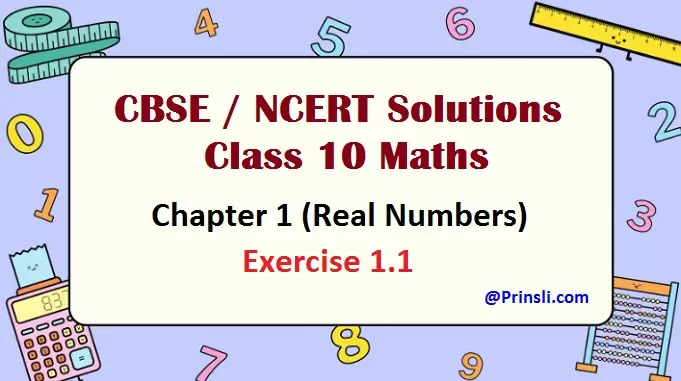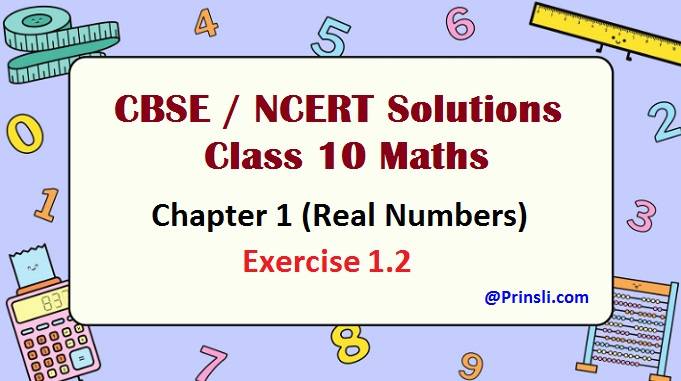
NCERT Solutions For Class 10 Maths Chapter 1 Real Numbers Exercise 1.1
In this article, NCERT Solutions for Class 10 Maths Chapter 1 Exercise 1.1 are given for free. Detailed answers to all the questions in Exercise 1.1 Chapter 1 maths class 10 Real Numbers provided. NCERT Solutions of Class 10 Maths (Real Numbers Ch 1 Ex 1.1) are extremely helpful while doing homework.
Read Also: Euclid’s division algorithm and how to find HCF in details
QUESTION 1 –
Use Euclid’s division algorithm to find the HCF of :
(i) 135 and 225
(ii) 196 and 38220
(iii) 867 and 255
SOLUTION –
(i) 135 and 225
In this case, 225 > 135, so apply Euclid’s division algorithm to 225 and 135, then we get
225 = 135 × 1 + 90
Since the remainder 90 ≠ 0, so apply the division lemma to 135 and 90, and we get
135 = 90 × 1 + 45
Again the remainder 45 ≠ 0, so apply the division lemma to 90 and 45, and we get
90 = 45 × 2 + 0
Now, the remainder has become zero, so our procedure stops. Since, in this stage, the divisor is 45, the HCF of 225 and 135 is 45.
Here, we notice that HCF (225, 135) = HCF (135, 90) = HCF (90, 45) = 45.
Short Method –
Apply Euclid’s division algorithm to find the HCF of 225 and 135 as follows:
225 = 135 × 1 + 90
135 = 90 × 1 + 45
90 = 45 × 2 + 0
Therefore, HCF (225, 135) = HCF (135, 90) = HCF (90, 45) = 45
(ii) 196 and 38220
In this case, 38220 > 196, so apply Euclid’s division algorithm to 38220 and 196, and we get
38220 = 196 × 195 + 0
Since, the remainder has become zero, stop procedures. Since, in this stage, the divisor is 196, the HCF of 38220 and 196 is 196.
Hence, we notice that HCF (38220, 196) = 196.
Short Method –
Apply Euclid’s division algorithm to find the HCF as follows:
38220 = 196 × 195 + 0
Therefore, HCF (38220, 196) = 196
(iii) 867 and 255
In this case, 867 > 255, so apply Euclid’s division algorithm to 867 and 255, and we get
867 = 255 × 3 + 102
Since the remainder 102 ≠ 0, so apply the division lemma to 255 and 102, and we get
255 = 102 × 2 + 51
Again the remainder 51 ≠ 0, so apply the division lemma to 102 and 51, and we get
102 = 51 × 2 + 0
Now, the remainder has become zero, so our procedure stops. Since, in this stage, the divisor is 51, the HCF of 225 and 135 is 51.
Here, we notice that HCF (867, 255) = HCF (255, 102) = HCF (102, 51) = 51.
Short Method –
Apply Euclid’s division algorithm to find the HCF as follows:
867 = 255 × 3 + 102
255 = 102 × 2 + 51
102 = 51 × 2 + 0
Therefore, HCF (867, 255) = HCF (255, 102) = HCF (102, 51) = 51
QUESTION 2 –
Show that any positive odd integer is of the form ,
or
, where
is some integer.
SOLUTION –
Let be any positive odd integer. Apply Euclid’s division algorithm to
and
, we get
, for some integer
and
.
The possible values of , that is, the possible remainders are,
, because
.
Substitute these possible values into , to find
:
If , then
or
If , then
If , then
If , then
If , then
If , then
That is, can be
,
,
,
,
or
.
But is an odd integer, so
cannot be
,
or
(because these numbers are divisible by 2 and so these are even not odd).
Thus, it is proved that, any positive odd integer is of the form ,
or
, where
is some integer.
QUESTION 3 –
An army contingent of 616 members is to march behind an army band of 32 members in a parade. The two groups are to march in the same number of columns. What is the maximum number of columns in which they can march?
SOLUTION –
Given Data:
Number of members in an army contingent = 616
Number of members in an army band = 32
Both the groups have to march in the same number of columns.
Our goal is to find the maximum number of columns in which they can march, that is, we need to find the HCF of 616 and 32.
Apply Euclid’s division algorithm to find the HCF of 616 and 32, we get
616 = 32 × 19 + 8
Since the remainder 8 ≠ 0, so again apply the division lemma to 32 and 8, we get
32 = 8 × 4 + 0
Now, the remainder has become zero, so our procedure stops. Since, in this stage, the divisor is 8, the HCF of 616 and 32 is 8.
That is, HCF (616, 32) = HCF (32, 8) = 8.
Hence, the maximum number of columns is 8 in which they can march.
QUESTION 4 –
Use Euclid’s division lemma to show that the square of any positive integer is either of the form or
for some integer
.
SOLUTION –
Let be any positive odd integer. Apply the Euclid’s division algorithm to
and
, we get
, for some integer
and
.
The possible values of , that is, the possible remainders are,
, because
.
Substitute these possible values into , to find
:
If , then
or
If , then
If , then
That is, can be
,
or
.
Now, find the square of , as per the question given,
If , then,
Assume that, , then
– – – Equation (1)
If , then,
Assume that, , then
– – – Equation (2)
If , then,
Assume that, , then
– – – Equation (3)
Hence, from equations (1), (2) and (3), it is verified that the square of any positive integer is either of the form
or
for some integer
.
QUESTION 5 –
Use Euclid’s division lemma to show that the cube of any positive integer is of the form ,
or
.
SOLUTION –
Let be any positive odd integer. Apply the Euclid’s division algorithm to
and
, we get
, for some integer
and
.
The possible values of , that is, the possible remainders are,
, because
.
Substitute these possible values into , to find
:
If , then
or
If , then
If , then
That is, can be
,
or
.
Now, find the cube of , as per the question given,
If , then,
Assume that, , then
– – – Equation (1)
If , then,
Assume that, , then
– – – Equation (2)
If , then,
Assume that, , then
– – – Equation (3)
Hence, from equation (1), (2) and (3), it is verified that, the cube of any positive integer is of the form
,
or
for some integer
.
Read Also: NCERT Solutions For Class 10 Maths Chapter 1 Exercise 1.2
- Tags: The first chapter of class 10th maths is Real Numbers. How do you find the HCF of Class 10? NCERT class 10 maths chapter 1 ex 1.1, CBSE ncert class 10 maths chapter 1 exercise 1.1 solutions, ncert class 10 maths ch 1 ex 1.1 solutions, Ex 1.1 Class 10 Maths Question 1, Ex 1.1 Class 10 Maths Question 2, Ex 1.1 Class 10 Maths Question 3, Ex 1.1 Class 10 Maths Question 4, Ex 1.1 Class 10 Maths Question 5
Copyrighted Material © 2019 - 2024 Prinsli.com - All rights reserved
All content on this website is copyrighted. It is prohibited to copy, publish or distribute the content and images of this website through any website, book, newspaper, software, videos, YouTube Channel or any other medium without written permission. You are not authorized to alter, obscure or remove any proprietary information, copyright or logo from this Website in any way. If any of these rules are violated, it will be strongly protested and legal action will be taken.


Be the first to comment